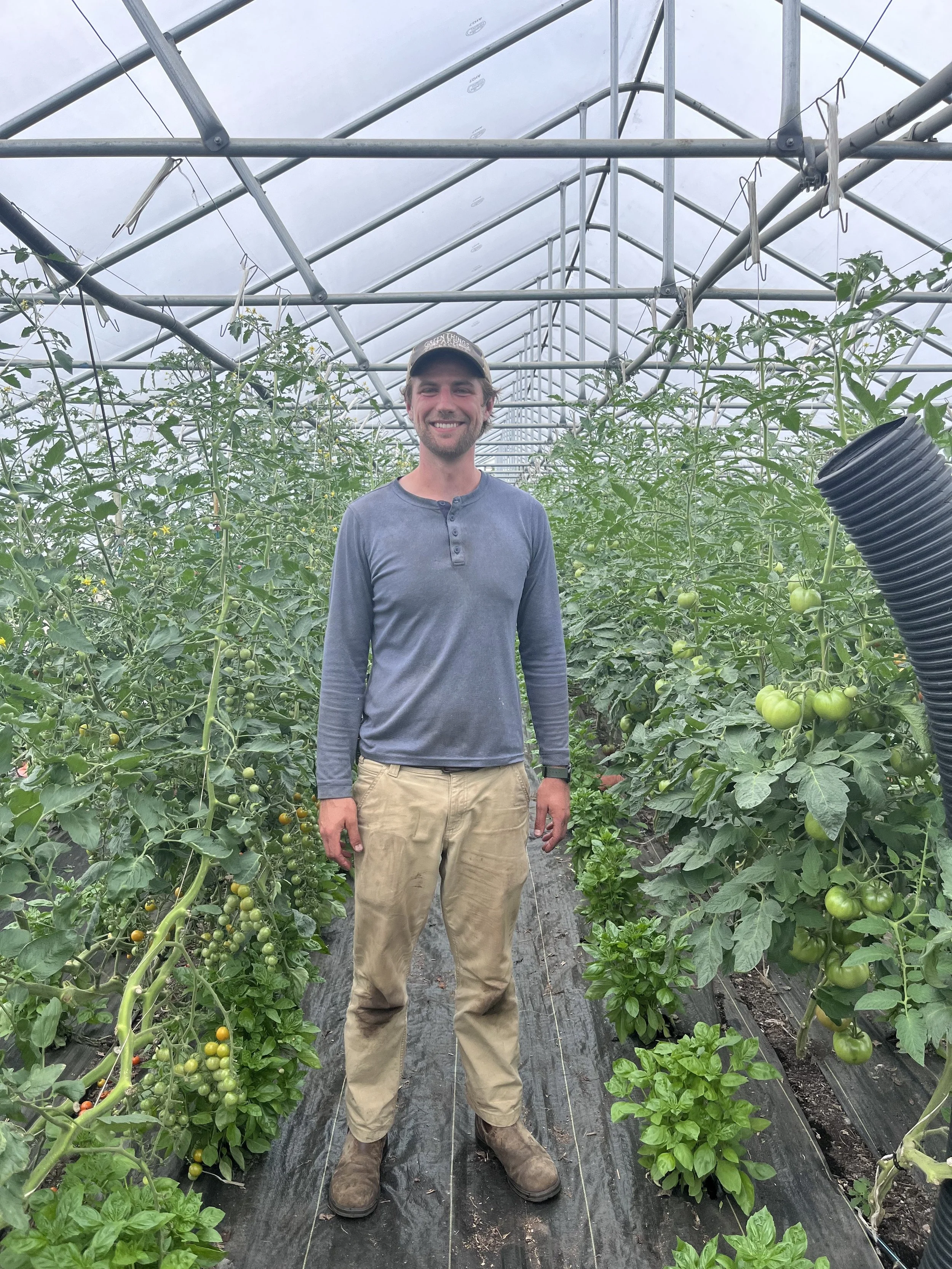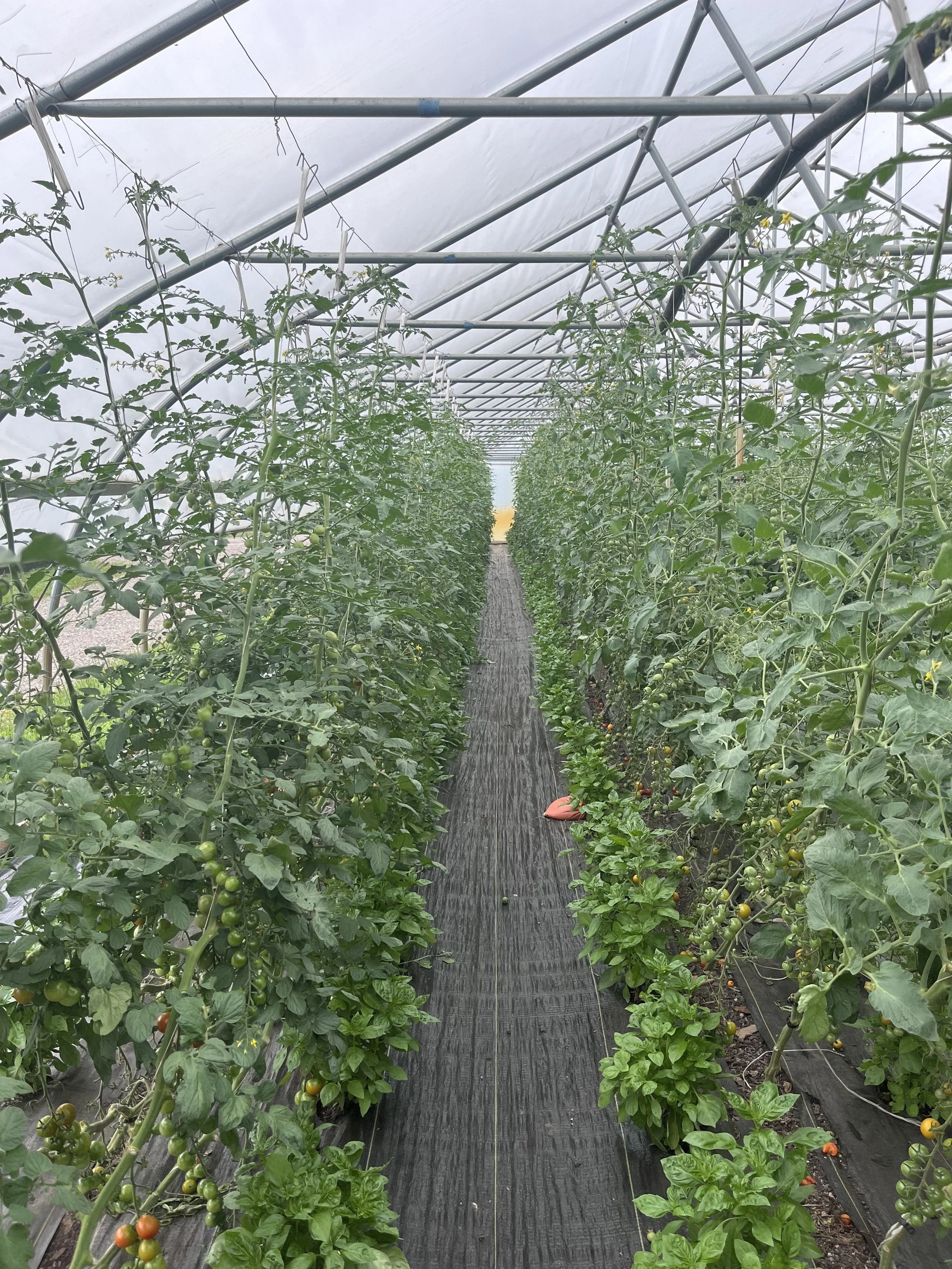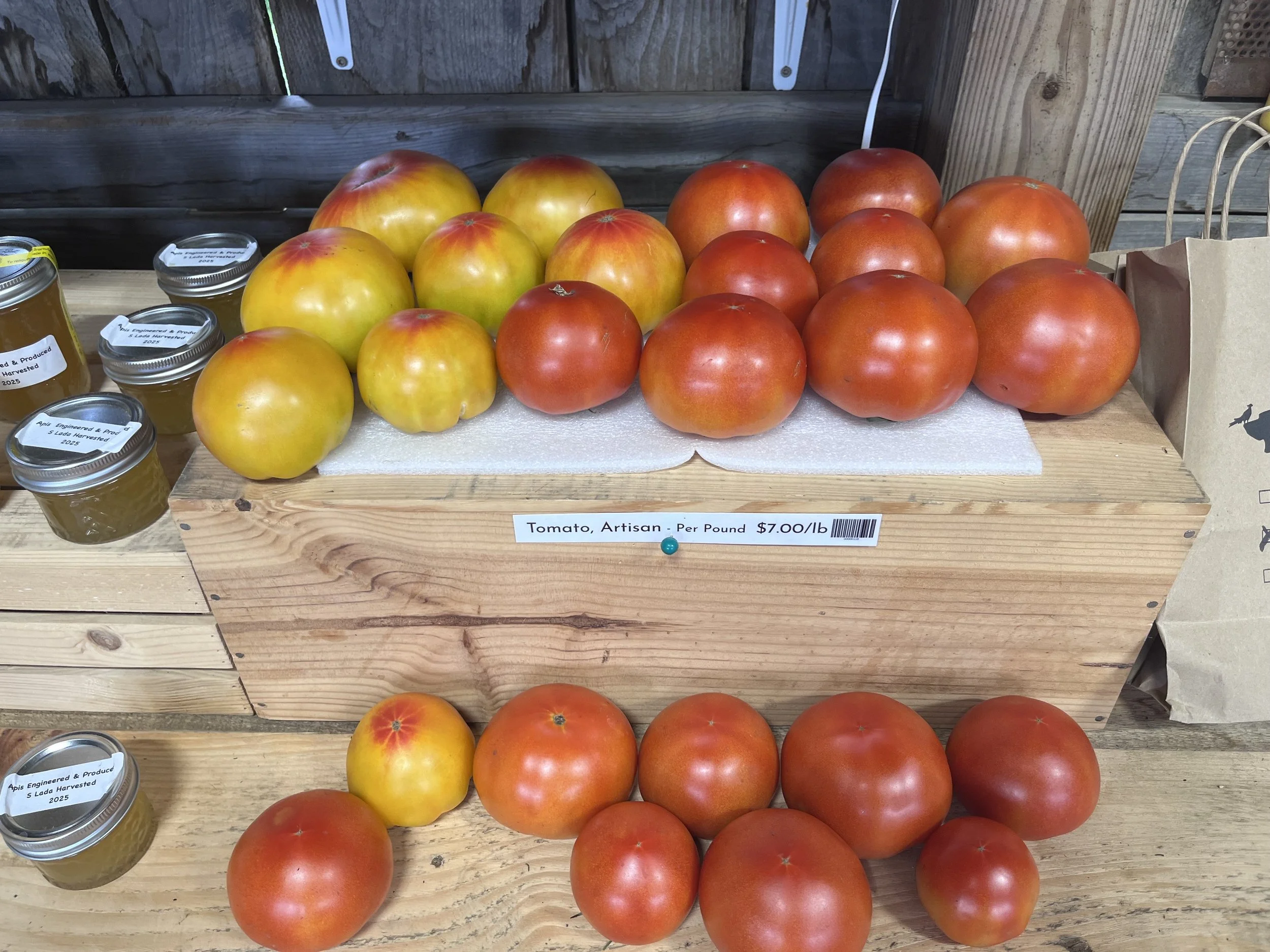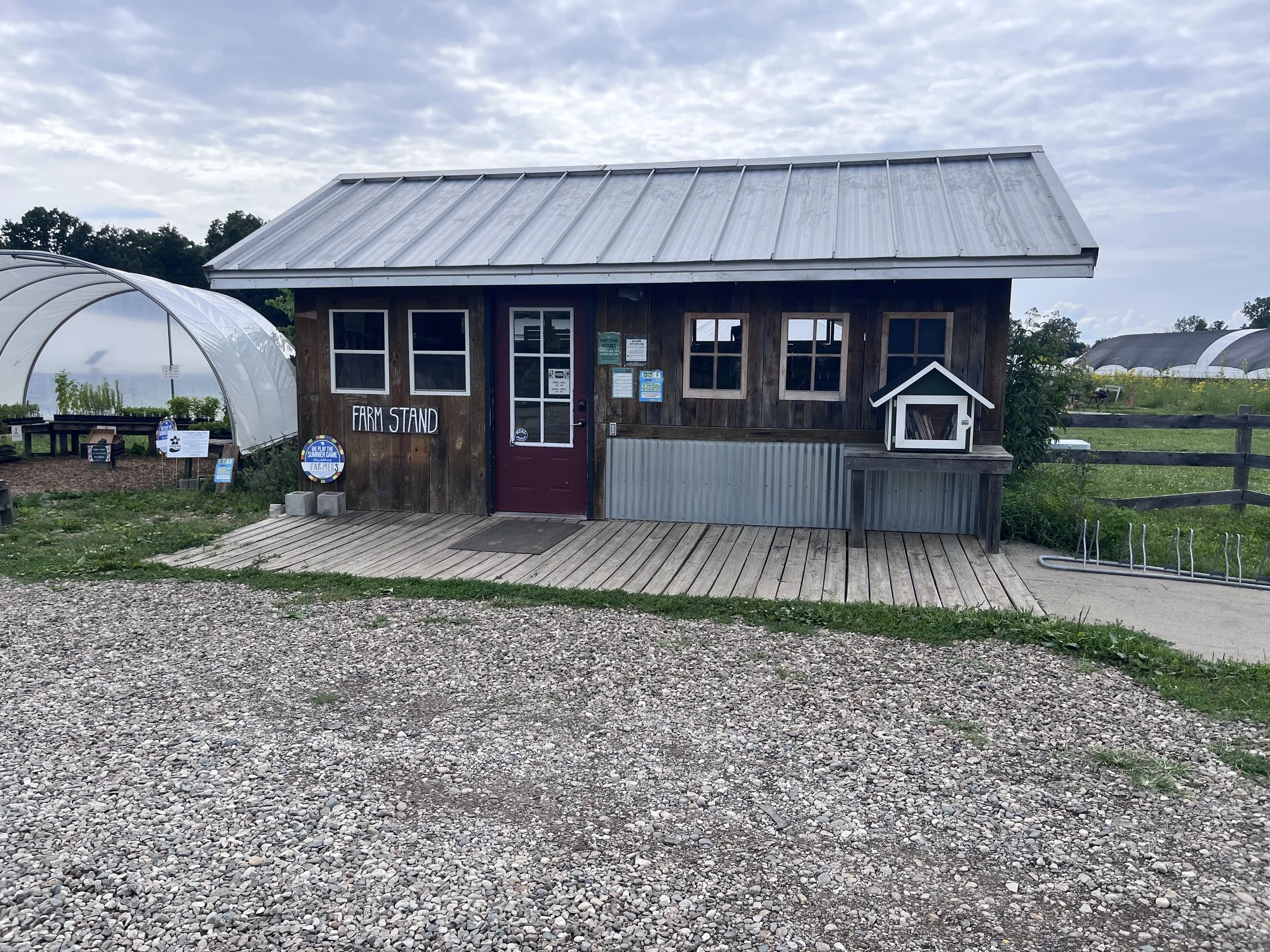The Local Tomato Difference: Green Things Farm Collective
As the Michigan summer moves into its final phase before fall, one of local foodivore’s favorite harvests finds its way into farmers markets across the state. We’re talking about the versatile, flavorful, and beautiful tomato. Unlike other beloved local produce like strawberries and asparagus, tomatoes have a relatively long season, but they do have a season indeed, as much as conventional grocery stores would show you otherwise. To learn more about what it takes to grow the delectable, local tomatoes that dwarf their super market counterparts, we talked with Eli, production assistant at Green Things Farm Collective about their tomato crops, growing practices, sales channels, and also their famous lettuce!
Green Things Farm Collective is one of the closest farms to Downtown Ann Arbor. Located just north of US-23, it’s less than 5 miles from the Kerrytown Farmers Market in Ann Arbor, equating to a ten minute detour by car. Green Things has existed in some capacity for 15 years, but it wasn’t until 2020 that the three businesses that make up GTFC came together as one farm. Ann Arbor Seed Company, Green Things Farm, and the Land Loom joined together, combining values and sharing farm management across multiple value driven and experienced farmers. In this age of consolidation, innovative and caring farmers working together as a collaborative effort can be a recipe for success for small to medium sized farms.
“Three years ago we did a big hiring season, increasing the size of the team. It’s really cool how Green Things has continued to evolve with the collective nature of five owners working together. They find their niche with their strengths and someone else fills their weaknesses.”
When we pick up a delicious tomato from your farmers market or farm stand, the fantastic taste and texture has us wondering what goes into local tomato farming that sets the harvests so high and above the usual tomato at a grocery store? Eli articulated to us how tomato farming is an upfront investment. The payoff of great harvests comes much later, after the plant has received the vast majority of its care.
“It takes a lot of labor; trellising and pruning. You need to take care of the plant before it’s producing any tomatoes and if you can put that work in up front, maintaining the plant, this can make the harvesting feel relatively easy.”
Tomatoes are a crop that can vary greatly in the systems the farmers set up for them. Tomatoes can be grown in greenhouses, hoop houses, or out in the field, with different degrees of care. Many farmers will prune the plant to support the most productive off-shoots of the stem. Trellising the tomato vines to keep them off the ground is essential for the fragility of the tomatoes themselves.
“Tomatoes are one of my favorite things to grow as you can get really technical with how you grow them. You can let them grow out in the field with no pruning and let them grow wild. You could go super high tech with multi-bay greenhouses where everything’s stale with hydroponic mediums. We’re somewhere in between with unheated hoop houses and irrigation. We control exactly how much water is getting to the plants, helping keep the leaves dry and preventing disease. Not having heat shortens our season, but we get a lot of the benefit of it being in a covered space.”
The more high tech, the more up-front costs farms will have to invest in themselves, and many small farms starting out don’t have the access to that capital. So, while greenhouses are used in Michigan to grow tomatoes for a longer season than the outside temperatures will permit, many farms don’t have that option. Products at Argus Farm Stop, and the availability of crops at Green Things Farm Collective as well, are representative of the constraints of the Michigan growing season.
There are many different varieties of tomatoes. You’ve probably heard the terms “slicer”, “heirloom”, “cherry” or “grape, or “artisan” at the grocery store, farmers market, or at Argus Farm Stop. What do all these terms mean?
Green Things “grows 6 varieties of tomatoes in the hoop houses, and probably about 5 in the field.” In the field, they’re growing varieties that are looped in as “sauce” tomatoes which are great for any tomato sauce you’re cooking up at home. They grow cherry tomatoes and what they call “artisan” in the hoop houses. Eli elaborated on the differences in these terms.
“We’ve got our artisan tomatoes, which people would call heirloom and slicers. When people see a type of tomato they think ‘yeah that’s an heirloom’. Technically if you look at the definition of heirloom, it’s not, because they’re hybrid tomatoes. Heirloom just means you can use the seeds. You can have an heirloom of any vegetable.”
Most of us think of the standard, spherical red tomatoes that are firm at the super market as “slicers”. More colorful, oddly shaped, softer tomatoes are usually called “heirlooms”. Smaller tomatoes are the beloved cherry or grape tomato that pair perfectly with a salad or pasta.
“[What defines an heirloom tomato,] the shape is the first thing that comes to mind. What I would call a slicer is that perfect round red tomato, whereas heirloom tomatoes are flatter. There’s a lot of variety in the heirlooms. One of our favorites on the farm is the Marigolds. It’s a yellow tomato with a kind of red bottom, so you get a multi-color look. We have another that’s a Cherokee Purple. You can definitely tell the difference in taste between something that’s grown locally and a lot of what you’re getting at the grocery store.”
Green Things Farm Collective is committed to growing food that is good for people, good for the soil, and good for the environment. This is represented by growing practices that are backed by certifications, such as their USDA organic certification and Real Organic Project certification, as well non-certified practices such as regenerative farming. What does growing regeneratively mean for our food?
“Regenerative has a lot more nuance. There’s not a clear definition or set of standards. It’s a style of growing or a philosophy about how you’re treating the land and the soil. For me, regenerative means that you’re leaving the soil better than you found it. [Before Green Things] this farm started out as conventional soy and corn. Over the years we’ve built these permanent beds and added organic matter through compost and cover crops. At this point these beds are sustainable so that we can keep growing on them year after year. If you’re taking vegetables out of the field you’re taking some of the fertility and minerals out of the soil so we still add compost and organic fertilizers to keep up the fertility.
“We try to rotate all of our crops, so that each year we’re growing different crop families in different fields. On top of that we have what we call our ‘insectories’, which are just strips of native plants along different growing fields. They’re a place where our beneficial insects can live and reproduce throughout the year. They can go out into our vegetables and pollinate and be predators to some of the pests that we deal with.”
Growing regeneratively and organically takes more time, labor, and money than conventional growing, but there are so many values that carry through to our food and our world. Taking the time to grow with these methods of care pays off for us and our world.
“There are things you can point to in the value of your food like food miles. If we’re bringing food in from California, Mexico, there’s a carbon footprint of that. People look at nutrient density. We believe that the vegetables we’re growing are more nutrient dense than some conventionally grown stuff. There’s a connection people make to their food that’s hard to measure but you can’t replace that connection with conventional, hard as a rock tomatoes. People enjoy being able to come to the farm to pick up the vegetables, see where they’re grown, walk through the fields and see that this thing that I’m eating is from the earth and I’m seeing the farmers who gathered it. This brings people a lot of joy and spiritual connection to their land. And then I think just for resiliency, just having people in your community who just know how to grow food feels valuable to me.”
When Argus Farm Stop employees think of Green Things Farm Collective, we think of beautiful, consistent, wonderfully grown, and deliciously tasting produce. If there was one vegetable that we think of though, it would probably be their huge, crisp lettuce heads and mixes. What goes into great lettuce farming?
“We have two main categories of lettuce; head lettuce, and our cut lettuce mix. We have five different varieties of head lettuce that we rotate throughout the season. Some of them are more heat tolerant. Those are the ones we’re growing in the hottest months of July and August. Some are more cold tolerant, we’re planting more of those varieties in the shorter seasons. Our cut lettuce mix stays the same throughout the whole season but it’s a combination of four different varieties in one bed.”
A farmer friend once told me that if they just wanted to make as much profit as possible, they’d just grow lettuce. Eli and I laughed about that and he said “there’s probably some truth to that.” Lettuce can be grown many times throughout the season where some crops like garlic are planted as early as October before their harvest comes around July.
“I think we grow 21 successions during the growing season with another succession in the hoops after that. If you can sell one bed 21 times, you’re going to get more profit out of that bed. It’s funny that we’re talking about lettuce and tomatoes because they are on opposite ends of the spectrum of growing just as far as where you’re putting in time and effort. With tomatoes, we’re planting in the hoop in April and we’re leaving it until September, maintaining that one planting. Lettuce is something that we plant every single week and we want to minimize the labor that we’re putting into each succession. Ideally we’re not even having to go in and weed after the lettuce. The lettuce will outpace the weeds. We’re pulling all the lettuce out of the field, putting a tarp down, and smothering the weeds that way. It’s interesting to think about those two vegetables and how different they are.
“Lettuce and tomatoes are probably the most profitable crop on this farm. Once the tomatoes start maturing, you’re getting three harvests a week during the growing season.That initial effort you put in continues to pay off. I think people also just really like lettuce and tomatoes and are aware of them.”
Like all farms, Green Things spreads out their products across many sales channels to maintain a diverse and consistent demand. In addition to selling through both Argus Farm Stop markets, Green Things Farm Collective maintains an on-farm stand with their products as well as other options from around Ann Arbor and Michigan. There are multiple other channels they go through as well.
“We sell at two farmers markets. We do the Ann Arbor Kerrytown Market Wednesdays and Saturdays, and the Farmington Farmer’s Market. I believe we’re the only organic certified farm at Farmington. That helps us a lot. The certification is something you can see. That draws a lot of people in”
At Argus Farm Stop, many customers are looking for organic options, and sometimes there is the impression that all of our products are organic. We sell a lot of produce that comes from a variety of farms with different growing practices. Many farms at Argus Farm Stop grow using organic practices but for various reasons, forego the expensive certification process. Some farms use non-organic, but more environmentally friendly practices like IPM, or Integrative Pest Management. It feels easier for us at farm stops to support all the different forms of growing practices and certifications. You can really see the benefit of certifications in a setting like a bigger farmers market.
“[Green Things also has] a few other wholesale accounts including Busch’s, and the Trinity Farms CSA. We have a couple smaller wholesale outlets. We have a CSA which is our 4th outlet. We have a spring, summer, and a fall CSA. We have a winter spinach club where it’s just spinach each week. We have a U-Pick cut flower CSA where people come onto the farm and pick a bouquet of flowers for themselves each week.”
Green Things Farm Collective represents so much of what Argus Farm Stop works to support every day. They are a fantastic farm, growing with dedicated and caring practices that support people and the planet. As Eli says “It’s an awesome place to work and we’ve got a great community of farmers who all share a similar passion for the work.”.
Next time you are at Argus Farm Stop or the Kerrytown Farmers Market, check out their products, or visit their farm for an up close look of their practices, while picking up your produce from their on-farm stand!
——————————————————————————————————————————————————————————————————————-
To incorporate your local tomatoes and lettuce, check out some great twists on the classic Bacon Lettuce and Tomato Sandwich from our Farm Stop Nutritionist Mary Balog!
Put a spin on your sauce:
-Garlic Mayo: Grate garlic cloves into mayonnaise.
-Chipotle Mayo: Combine the above recipe for garlic mayo with chipotle adobo sauce and a splash of soy sauce.
-Herb Aioli: Mix mayo with lemon zest, lemon juice, minced shallot, and fresh herbs like chives, basil, thyme, or parsley.
-Everything Bagel Spread: Combine mayo, sour cream, everything bagel seasoning, white wine vinegar, and Dijon mustard.
-Sriracha-Tahini Sauce (vegan): Mix tahini with sriracha, lemon juice, maple syrup, and a bit of water
-Garlic-Dill Hummus (vegan): Blend hummus with fresh dill, lemon juice, and roasted garlic.
-Sun-Dried Tomato Aioli (vegan): Blend silken tofu with sun-dried tomatoes, basil, garlic, and lemon.
For those who are looking for a local and plant-based alternative to the "B" (bacon), here are some suggestions (but an LT sandwich is also delicious with the right tomato, sliced into thick slabs).
Any of the below suggestions can be sliced into strips or slabs, marinated in a mixture of 3 tbsp tamari or soy sauce, 1 tbsp maple syrup, 1 tsp smoked paprika, 1 tbsp nutritional yeast, and 1 tbsp olive oil. Marinate for at least 30 minutes then bake, pan-fry, or air-fry until crisp. You may need to increase the amounts depending on how much you are making.
-Tempeh bacon: Thinly sliced and marinated tempeh cooked until crispy, provides a chewy, smoky and flavorful substitute. You can find The Brinery tempeh in our freezer section. **Note**The Brinery also has lots of other great recipes for flavoring tempeh on their website here!)
-Tofu Bacon: Similar to tempeh bacon, thin slices of extra-firm tofu marinated and baked or fried to a crispy texture can be a delicious alternative. You can find Rosewood tofu in our refrigerator section.
-Vegetable bacon: Eggplant, carrot, zucchini, and mushroom can all be marinated and baked or fried until crisp to offer a satisfying crunch and savoriness to a plant-based BLT. For the eggplant, zucchini, and carrots, slice lengthwise into slabs or strips. A vegetable peeler can also be used for the carrots and zucchini to make vegetable ribbons. When choosing mushrooms, you can usually find oysters, trumpets, shiitakes, or lion's mane on our shelves, which provide a robust and hearty texture for a plant-based BLT.






